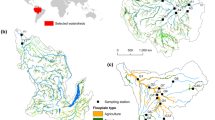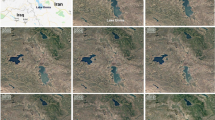Abstract
Purpose
In Lake Constance, on average, underflows occur several times a year due to flood events in the River Rhine. During these events, large amounts of sediments as well as oxygenated riverine water are transported into the hypolimnion of the lake. The purpose of this study was to quantify the effect on deep water renewal and study the factors that influence the occurrence of underflows.
Materials and methods
A three-dimensional hydrodynamic model was set up. To calibrate the model, the flood event of August 2005, whose peak discharge was slightly below the discharge with a return period of 100 years, was simulated and results compared to measurements. The model was then validated simulating several further, smaller underflow events. In a model study of the flood event of June 2012, the influence of underflows to deep water renewal was investigated by using different tracers to mark the inflowing water as well as the epilimnic water. By varying the discharge, suspended solid concentration, and water temperature of the River Rhine in the model, the influence of these factors on the occurrence and spreading of underflows was studied.
Results and discussion
The simulations show that the model was able to reproduce the occurrence and spreading of under-flows satisfactorily. The tracer study indicates that a fair amount of epilimnic water was entrained into the underflow and therefore enhances deep water renewal. It was shown that the main influence factor on the occurrence of underflows was the concentration of suspended solids, followed by the discharge. Water temperatures have a relatively small influence. These results are confirmed by two underflow events in 2013 which occurred due to extreme high concentrations of suspended sediments without any increase in discharge. Although not part of the model study, it was suspected that the grain size distribution of the suspended solids also exerts a significant effect on the underflow.
Conclusions
The hydrodynamic model was able to reproduce the main processes involved in the occurrence of underflows and therefore is a suitable tool for the investigation of influence factors on the build-up of underflows as well their effects on the lake’s sedimentation and erosion processes and water quality.










Similar content being viewed by others
References
Ambrosetti W, Barbanti L, Sala N (2003) Residence time and physical processes in lakes. J Limnol 62(Suppl. 1):1–15
Appt J (2003) Analysis of basin-scale internal waves in Upper Lake Constance. Mitteilungsheft 123, Institut für Wasserbau, Universität Stuttgart
Appt J, Imberger J, Kobus H (2004) Basin-scale motion in stratified Upper Lake Constance. Limnol Oceanogr 49(4):919–933
BMLFUW (2015) Hydrografisches Jahrbuch von Österreich 2013 – Daten und Auswertungen. Bundesministerium für Land- und Forstwirtschaft, Umwelt und Wasserwirtschaft, Wien
Eder M, Kobus H, Helmig R (2008a) Dreidimensionale Modellierung der Hydrodynamik im Bodensee. WasserWirtschaft 98(10):16–21
Eder M, Rinke K, Kempke S, Huber A, Wolf T (2008b) Seeweite Bodensee-Messkampagne 2007 als Test für BodenseeOnline. WasserWirtschaft 98(10):34–38
Eder M, Wessels M, Dare J (2014) Underflows in Lake Constance—numerical modeling, instrumental observations and sediment data. Geophys Res Abstr. EGU2014–10709
Gilfedder BS, Petri M, Wessels M, Biester H (2009) An iodine mass-balance for Lake Constance: insights into iodine speciation changes and fluxes in a limnic setting. Geochim Cosmochim Acta 74(11):3090–3111
Hipsey MR, Antenucci JP, Hamilton D (2012) Computational aquatic ecosystem dynamics model: CAEDYM v3.2 science manual. Centre for Water Research, University of Western Australia, Perth
Hodges B, Dallimore C (2012) Estuary, lake and coastal ocean model: ELCOM v2.2 science manual. Centre for Water Research, University of Western Australia, Perth
Hodges B, Imberger J, Saggio A, Winter KB (2000) Modeling basin-scale internal waves in a stratified lake. Limnol Oceanogr 45(7):1603–1620
Imberger J, Patterson JC (1981) A dynamic reservoir simulation model—DYRESM 5. In: Fischer H (ed) Transport models for inland and coastal waters. Proceedings of a Symposium On Predictive Ability. Academic Press, New York, pp 310–361
Imberger J, Patterson JC (1990) Physical limnology. Adv Appl Mech 27:303–475
Lambert A, Giovanoli F (1988) Records of river born turbidity currents and indications of slope failures in the Rhône delta of Lake Geneva. Limnol Oceanogr 33:458–468
Lang U, Paul T (2008) Zustandsbeschreibung und Prognose mit der Daten- und Methodenbank BodenseeOnline. WasserWirtschaft 98(10):39–44
Lang U, Kobus H, Mehlhorn H (2008) BodenseeOnline als Entscheidungs- und Unterstützungssystem. WasserWirtschaft 98(10):45–48
Mulder T, Syvitski JPM, Skene KI (1998) Modeling of erosion and deposition by turbidity currents generated at river mouths. J Sediment Res 68(1):124–137
Rinke K, Rothhaupt KO (2008) Das ökologische Modell des Bodensees: Konzept, Simulation und Test an Langzeitdaten. WasserWirtschaft 98(10):26–30
Sloff CJ (1994) Modelling turbidity currents in reservoirs. Communications on hydraulic and geotechnical engineering, report no. 94–5, Delft University of Technology
Spigel RH, Imberger J, Rayner KN (1986) Modeling the diurnal mixed layer. Limnol Oceanogr 31:533–556
Van Rijn LC (2004) Extreme transport of sediment due to turbidity currents in coastal waters. 29th International conference for coastal engineering, Proc., Lisbon, Portugal, 2004
Author information
Authors and Affiliations
Corresponding author
Additional information
Responsible editor: Gudrun Hillebrand
Rights and permissions
About this article
Cite this article
Mirbach, S., Lang, U. Density-driven underflows with suspended solids in Lake Constance. J Soils Sediments 18, 3145–3152 (2018). https://doi.org/10.1007/s11368-017-1753-x
Received:
Accepted:
Published:
Issue Date:
DOI: https://doi.org/10.1007/s11368-017-1753-x




